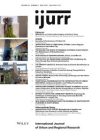Entire metropolitan areas are often seen as fundamental components of the emerging global space–economy. The national and global roles of central cities, however, may lead them in fundamentally different economic and political directions from their hinterlands if the functions of the cities are decreasingly complementary to those of their surrounding areas. In particular, the political complexions of city and hinterland may come to reflect different cultural and economic orientations as a result of divergence in political–economic trajectories between the two. This possibility is explored using the example of the northern Italian city of Milan and its hinterland, taken as the provinces of Bergamo, Como, Lecco and Varese, and the rest of the province of Milan outside of the city with respect to geographical patterns of support for the regionalist/separatist movement, the Northern League, over the course of three national elections: 1992, 1994 and 1996. Putatively a movement representing the interests of northern Italy as a whole, the Northern League’s stands on issues tended increasingly to represent the identities and interests of the small manufacturing firms that dominate part of the fringe of the metropolitan area, whereas Milan itself has an economic base of advanced services and national–oriented manufacturing firms that would lead to the expectation of a very different political orientation. Analysis of election returns suggests a divergence between city and hinterland that is in large part accounted for by their distinctive economic trajectories. There is no simple identity between a city and its metropolis.
Details
Written by:
John Agnew, Michael Shin, Giuseppe Bettoni
Digital Object Identifier (DOI)
10.1111/1468-2427.00379
About DOI
Read full article as PDF
Read full article as HTML
See the references for this article
